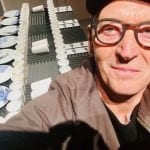Voids, rhomboids, meshes and point clouds……
I have always been fascinated with how things appear in the world, how they are made, what they represent and how this representation changes through time. Back in 2011, I was asked to curate a show at the BOX (Plymouth) on the theme of unlocking the archived artefacts the museum holds and re-interpret them for new audiences, through both analogue and digital means. We were given free rein to plunder the stores (white gloves of course) and learnt a huge amount about how historical artefacts are managed, understood and cherished. My particular choice was group of artefacts, made in Plymouth during the 1700’s by William Cookworthy, a Quaker, a chemist, an innovator and all round entrepreneur. These four figures were the beginning of English porcelain (later to become Wedgewood) and were conceived commercially as a rival to the Chinese porcelain trade of the time.
Link to the figures held at the V&A
The objects are fairly crude and created in Plymouth in 1768 or 1769, the figurines were probably intended as decorative tableware and are supposed to represent the four continents, often called the ‘Four Quarters’ of the world, known to Europeans at the end of the eighteenth century, for us now, they are loaded, colonial and imperial signifiers of a past in need of contextualizing. These objects were what bought me to scanning, as a means to see these designed objects, differently and the means of scanning bought me to this data fellowship. Much of my work through the fellowship will further define our changing attitudes to things, places and spaces.
Originally I had used lens based scanning, to scan these figures, but moved to lidar for more detail and the means to use the scans in/on different digital platforms. Lidar is a method for measuring distances by illuminating the object, the landscape, the architecture etc., with laser light and measuring the reflection with a sensor. Differences in laser return times and wavelengths can then be used to make digital 3-D representations, for some time now It has been used terrestrially, from the air and recently on mobile applications.
More detail on different scanning techniques
Although it is an extremely exact method of seeing the world, I still like the voids and glare (sometimes called noise) that it produces, it makes things, geospatial environments, look dusty, spectral, as if the readings it is producing, can see the live quality of its capture. The first part of my work over the coming months will focus on the environment, how this can be seen to evaluate data capture, what this physical data tells us and what we can use/learn from this. I am hoping that the showing of these early results will increase public engagement of ecological debate and cultural experience. There is a feeling that there is a deficit in meaningful methods and tools for data collection, so by visualizing, compiling, building, differently, with ‘intrinsic’ value and meaningful engagement, this early research will explore the challenges associated with measuring ‘instrumental’ and ‘intrinsic’ value in laser scanning, using locations that already have familiar narrative.
As I start thinking about how physical data can communicate something different, I am aware that today data is everywhere, in all its manifestations. It deals both with the tangible and the intangible. The artificial environments in which we spend our lives are acts of data, which also has impact upon the natural environment. So, too are social and political systems the intangible acts of data. Because data affects every aspect of our material and biological world it can no longer be exempt from the moral and ethical issues of citizenship. The ubiquitous products of data that make-up our artificial environment now constitute ‘ a new parliament of things’ that regulates and governs our everyday experience of life. Everyone (well most sensible people) pretty much get the challenges of the 21st century, urgently needing the invention of new survival strategies. I believe the invention of these strategies are intrinsically linked to data. I also believe that the digital age renders the power of data so great as to be a new body politic, needing its own forms of governance.
Hopefully as the work progresses, I can find ways of connecting this digital scanning form, back to ways of human space. By linking tangible objects and environments to the symbolic values stored within people. We need to reawaken the dynamic relationships between artefacts, environments and ourselves by moving the exterior to the interior to start exploring inner space again, making the intangibles more powerful and more meaningful.

